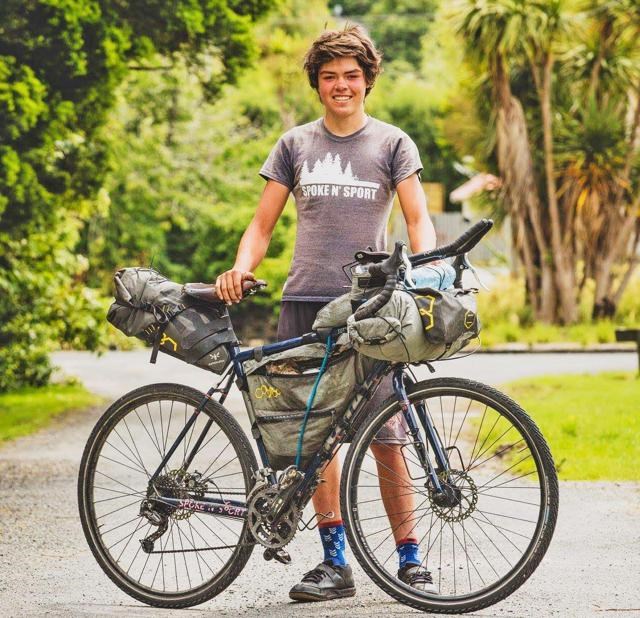A young cycling enthusiast who was one of the youngest people ever to circumnavigate the world on a bicycle shared some of his adventures with members of the Weyburn Rotary Club via Zoom.
B’yauling Toni of Saskatoon is a fellow cyclist with Rotary member Mal Barber, and had a presentation on his bike trip around the world, a journey that took him 206 days to complete in 2018 and cost him a total of around $8,000.
Toni did a fundraiser with the event, raising funds online to help cover his own costs and to donate to the Outdoor School program in Saskatoon, which provides outdoor education to Grade 11 students.
He explained he grew up in a low-income family that never owned a vehicle, so they got around by bike or by walking. He first got the bug for long-distance cycling at the age of 12, when he rode his Walmart bike with his dad and brother from Saskatoon to Vancouver, a trip that took about three weeks to complete.
“I fell in love with travelling on a bicycle. I loved the freedom, the things you see at that speed. You just take in so much more of your surroundings,” said Toni. “It’s an interesting way to travel.”
He later did a solo bike trip to Vancouver at the age of 15, and the year after that he rode the Great Divide mountain bike route, which takes you from Banff to the U.S.-Mexico border.
“From there, I got an idea of doing something bigger. I was graduating from high school at 17 years old. I wanted to do another tour, and I came up with the idea of cycling around the world,” said Toni.
Looking into this idea, he found the record-holder was a 19-year-old, who circumnavigated the world in 2015, so he decided to take a shot at making the journey at age 17.
Some of the conditions included that you have to cycle a minimum of 30,000 km, all in the same direction, and he had to cross two antipodal points, locations that are on opposite points of the globe. He selected as his points Madrid, Spain and Wellington, New Zealand, and his start and finish point was Saskatoon, going in a west-to-east direction.
The route he plotted out would take him through 13 countries and just over 30,000 km, and he began by riding 6,000 km to Halifax.
From there he flew to Portugal, and rode through Portugal, Spain, France, Belgium, the Netherlands, Germany and all the way to Estonia. The biggest part of the journey was to then ride through Russia to Mongolia, then to China, from where he flew from Shanghai to Perth, Australia, and finally to New Zealand before flying to Vancouver for the final leg of his trek.
He rode in the dead of winter, in January, for this last stretch, through the Rocky Mountains and across the Prairies back to Saskatoon.
Toni said he found riding in Canada and Europe were relatively easy with good infrastructure for cycling (especially through Europe), but things became very different in Russia.
The first challenge in Russia was his visa required him to make the length of his journey, about 6,500 km, through to Mongolia in 30 days, and secondly, he was in a country where no one spoke English, and there were no allowances made for cycling.
He described the terrifying experience of riding on narrow highways with no shoulders, with large trucks passing within a foot of him at 110 km an hour.
“It was my first time in surroundings that were way outside of my comfort zone,” said Toni, explaining that to make the trip in 30 days, he had to ride over 200 km a day, usually around 10 hours a day without a break.
“By no means were they aggressive drivers. In Saskatchewan, and in Canada in general, the biggest issues are the angry, aggressive drivers. They will purposefully drive close to you and yell at you to get off the road. It’s not like that in Russia at all. I never had any road rage drivers at all. There’s a different mentality,” Toni explained, noting that in Russia, the bigger vehicles have the right-of-way, and a cyclist is simply expected to move out of the way.
“In the beginning I thought they were just being rude to me, but that’s just the way they drive. I had a guy pass me at 110 km an hour maybe a foot away from me, because there’s no shoulder, and this guy waved at me with his thumb up, saying ‘good job’, and cheering me on. That’s when I realized they have no idea that I’m scared. They’re not aggressive or angry, they’re cheering me on,” he said.
Mongolia, however, was another major challenge, as roads were sand or gravel, and large parts of it were in the mountains or in the Gobi Desert, and Toni experienced some extreme cold and snow conditions, along with an encounter with a wolf late at night on a road.
In China, he found the people there were curious and very generous, wanting to help him out, with beautifully smooth highways that were nice to cycle on.
“I’m half Taiwanese, so I have some Asian ancestry. It was neat to see. It’s hard to know what a people is like before you go there,” he said.
Toni’s biggest challenge in Australia was traversing the Nullarbor Plain, a 1,200-km stretch between towns across a treeless plain. Once he made it through there, he rode through the Golden Coast area to Sydney and flew to New Zealand, and cycled the two islands before flying to Vancouver.
The most difficult part of the final 2,000 km was cycling in -30 weather, in January, across the Prairies back to Saskatoon.




